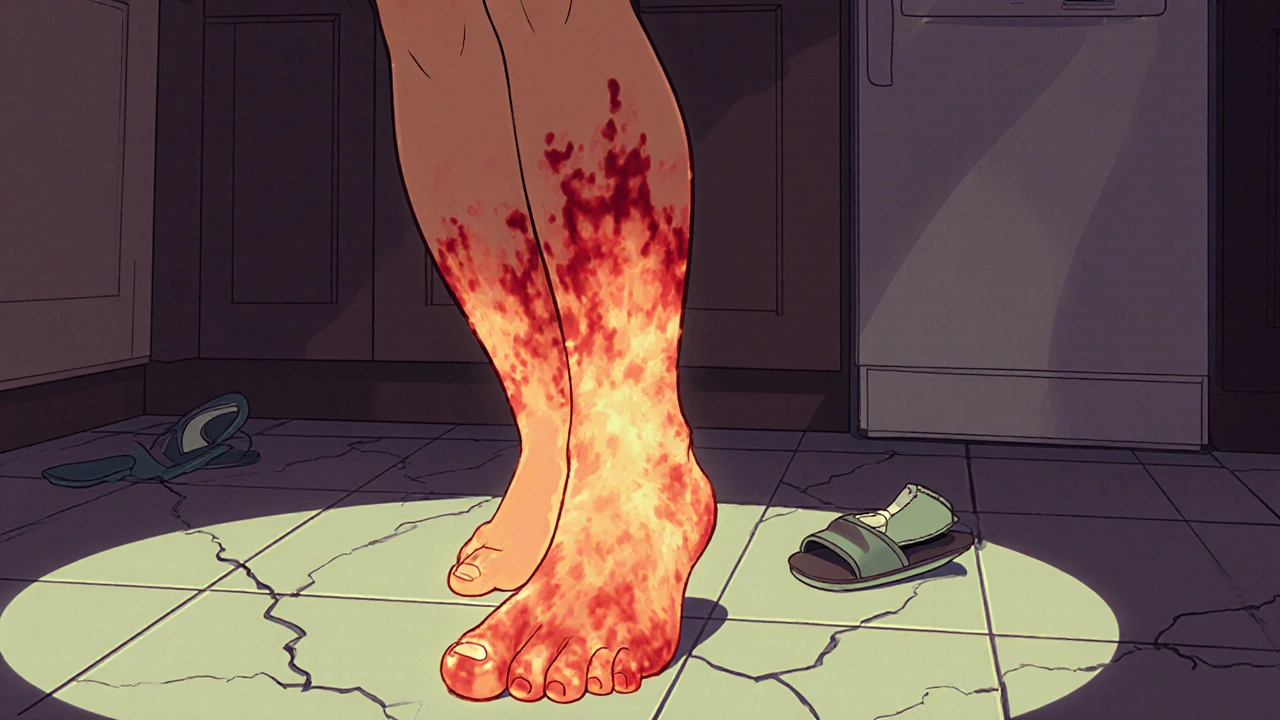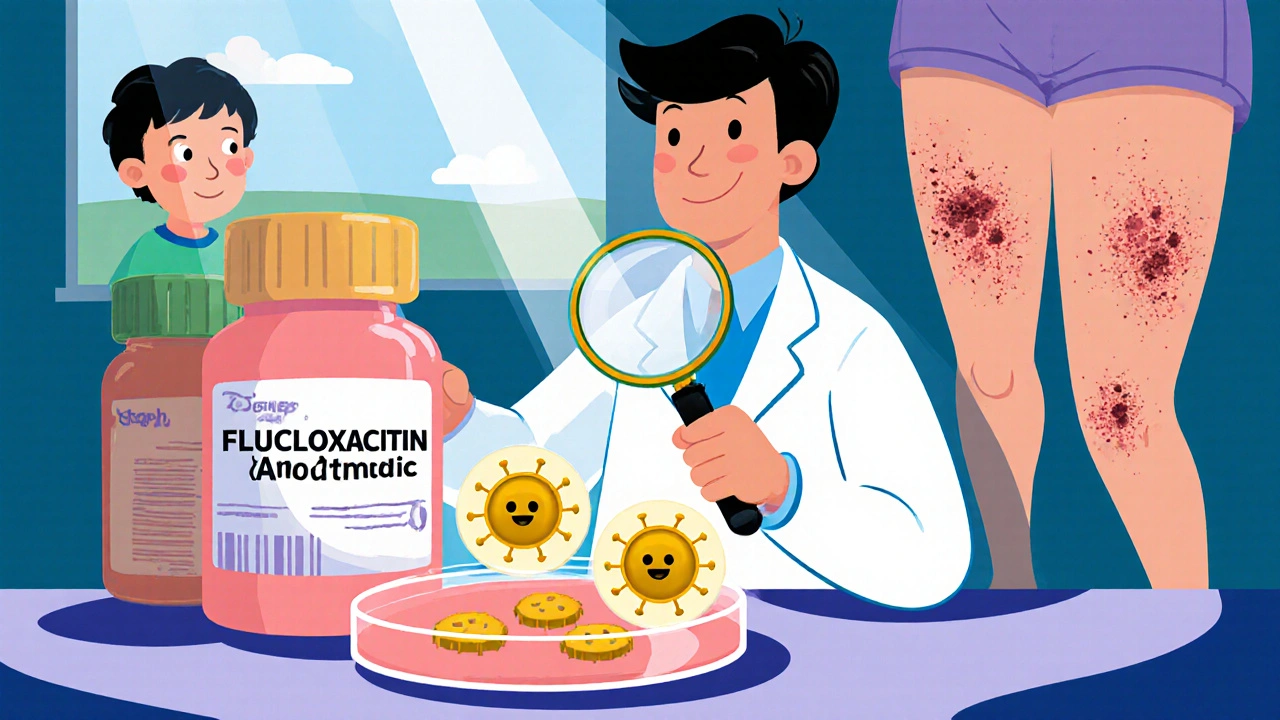Two kids come home from school with red, crusty sores around their noses. A neighbor wakes up with a swollen, hot patch on her leg that feels like it’s burning. Both have skin infections-but they’re not the same. One is impetigo, the other is cellulitis. They look similar at first glance, but the way they spread, how deep they go, and which antibiotics work best are completely different. Get it wrong, and you risk turning a simple rash into a life-threatening infection.
What Impetigo Really Looks Like
Impetigo is the most common bacterial skin infection in children, especially between ages 2 and 5. You’ll see it in daycare centers, schools, and households where kids share towels or toys. It starts as tiny red bumps or blisters, usually around the nose and mouth, but can show up anywhere the skin is broken-from a scratch to an eczema flare-up.
The classic sign? Honey-colored crusts. These aren’t just dried pus-they’re thick, sticky, and golden-yellow, formed when fluid from ruptured blisters dries on the skin. This is called nonbullous impetigo, and it makes up about 70% of cases. The rest are bullous impetigo, which features larger, fluid-filled blisters that burst easily, leaving a ring-like edge. Both are caused by Staphylococcus aureus or Streptococcus pyogenes.
What makes impetigo tricky is how fast it spreads. One child can infect half a classroom in a week. It doesn’t need broken skin to start-S. aureus can invade healthy skin, especially in warm, humid weather. That’s why it spikes in summer and early fall. Parents often mistake it for a spider bite or allergic reaction. But if you see crusts forming over a day or two, and it’s spreading, it’s likely impetigo.
Cellulitis: When the Infection Goes Deep
Cellulitis doesn’t just sit on the surface. It burrows into the dermis and fat layer under the skin. It’s not a rash. It’s an invasion. You’ll know it by the way the skin feels: hot, swollen, tight, and tender to the touch. The redness doesn’t have clean edges like a ringworm-it bleeds outward in a messy, spreading pattern. Sometimes, the area leaks clear or yellow fluid. Fever, chills, or feeling generally sick? That’s a red flag.
It most often hits the lower legs, but can appear anywhere-arms, face, even around surgical wounds. People with diabetes, poor circulation, or eczema are at higher risk. A small cut, insect bite, or even a cracked toe can be the entry point. Unlike impetigo, cellulitis rarely spreads person-to-person. It’s an individual breakdown of the body’s defenses.
There’s a related condition called erysipelas, which looks like cellulitis but has sharp, raised borders and is almost always caused by strep. It’s more common on the face and feels like a sunburn with a ridge around it. Doctors treat it like cellulitis, but the sharper edge helps tell them apart.
Why Antibiotic Choice Matters
Both infections are bacterial, but they need different weapons. Give someone impetigo the wrong antibiotic, and it might clear up slowly-or come back. Give someone cellulitis a weak one, and it could turn into sepsis.
In the UK and Belgium, flucloxacillin is the go-to first-line drug for both. It’s a penicillin-type antibiotic that kills staph and strep-exactly the bugs behind most cases. It’s cheap, effective, and well-tolerated. But if you’ve had antibiotics before, or the infection isn’t improving, resistance becomes a problem. That’s where MRSA (methicillin-resistant Staphylococcus aureus) comes in.
MRSA doesn’t respond to flucloxacillin, amoxicillin, or most common penicillins. In the US and parts of Europe, MRSA now makes up 30-50% of skin infections in some hospitals. If someone has a history of hospital stays, recent surgery, or lives in a crowded setting like a prison or nursing home, doctors suspect MRSA early.
For MRSA, you need alternatives: clindamycin, doxycycline, or trimethoprim-sulfamethoxazole. These are broader-spectrum and reserved for resistant cases. In severe cellulitis-with fever, rapid spread, or immune problems-patients get IV antibiotics like vancomycin in the hospital.
France takes a different path. They use amoxicillin for cellulitis and pristinamycin for severe impetigo. Why? Because resistance patterns vary by region. What works in Leeds might not work in Marseille. That’s why local guidelines matter more than national ones.

Topical vs. Oral: When to Use What
For small, isolated patches of impetigo, topical treatment works just as well as pills. Mupirocin ointment (sold as Bactroban) is applied three times a day for 7-10 days. Studies show it clears up 90% of non-bullous cases. No need to swallow antibiotics if you don’t have to.
But if the infection covers a large area, is spreading fast, or involves multiple family members, oral antibiotics are better. Flucloxacillin (or clindamycin if MRSA is suspected) for 7-10 days is standard. Kids often get liquid forms, adults get capsules.
Cellulitis? Never just a cream. Even if the red area looks small, the infection is already under the skin. Oral antibiotics for 5-14 days are required. If the person is vomiting, has a high fever, or can’t walk because their leg is swollen, they need hospital care and IV antibiotics. Delaying treatment by more than 48-72 hours increases the risk of complications like abscesses, blood infections, or tissue death.
What Happens If You Wait Too Long
Impetigo can heal on its own in a few weeks-but it won’t stop spreading. Kids keep scratching, touching their faces, and then their toys. Parents end up infected too. In rare cases, strep-caused impetigo can lead to post-streptococcal glomerulonephritis-a kidney problem that shows up weeks later with swelling, dark urine, and high blood pressure.
Cellulitis is far more dangerous. If untreated, the bacteria can enter the bloodstream, causing sepsis. Or they can spread to deeper tissues, leading to necrotizing fasciitis-the “flesh-eating” infection. Even without that, recurrent cellulitis is common. One in three people who’ve had it once will get it again within two years. That’s why doctors look for underlying causes: foot ulcers in diabetics, leg swelling from poor veins, or chronic skin conditions.

Prevention: Simple Rules, Big Impact
You can’t always stop an infection-but you can stop it from spreading.
- Wash hands often, especially after touching infected skin.
- Cover sores with clean bandages until they crust over.
- Don’t share towels, clothing, or bedding with someone infected.
- Keep cuts and scrapes clean and covered. Use soap and water, then apply an antiseptic.
- If you have eczema, manage it well. Dry, cracked skin is a gateway for bacteria.
- Children with impetigo should stay home from school or daycare until 24 hours after starting antibiotics.
For people with recurrent cellulitis, long-term low-dose antibiotics (like penicillin V) may be prescribed to prevent future episodes. Compression socks help if poor circulation is the cause. Diabetics need regular foot checks.
When to See a Doctor
Don’t wait for it to get worse.
- Impetigo: If sores spread beyond one area, don’t improve after 3 days of treatment, or if your child has a fever.
- Cellulitis: If the red area is growing fast, you have chills or fever, the skin feels numb or looks purple, or you have diabetes or a weakened immune system.
Emergency care is needed if you feel dizzy, have trouble breathing, or the infection is near your eyes or genitals. These areas are high-risk for rapid spread.
Is impetigo the same as a staph infection?
Impetigo is a type of staph infection, but not all staph infections are impetigo. Staph can cause boils, abscesses, or cellulitis too. Impetigo specifically refers to the crusty, contagious sores on the skin’s surface, mostly in children.
Can I treat impetigo with over-the-counter creams?
No. Antibiotic ointments like Neosporin won’t work. Impetigo needs prescription-strength mupirocin or oral antibiotics. OTC creams might soothe the skin but won’t kill the bacteria causing it.
Why is flucloxacillin used in the UK but not everywhere?
Flucloxacillin is effective against the most common strains of staph and strep in the UK. In places like France or the US, where MRSA is more common, doctors avoid it and use alternatives like clindamycin or doxycycline. It’s about local resistance patterns, not one-size-fits-all.
Does cellulitis always need antibiotics?
Yes. Cellulitis is a deep infection that won’t clear on its own. Even mild cases need oral antibiotics for at least 5 days. Without treatment, it can spread to the blood or deeper tissues, which can be fatal.
How long does it take for antibiotics to work?
For impetigo, you should see crusts drying up and less redness in 2-3 days. For cellulitis, swelling and pain should start improving within 48 hours. If there’s no change after 3 days, call your doctor-you might need a different antibiotic or stronger treatment.
What Comes Next
Antibiotic resistance is changing how we treat these infections. More doctors are now taking swabs before prescribing-especially for recurrent or treatment-resistant cases. Rapid tests that identify staph vs. strep and detect MRSA in under an hour are becoming available in hospitals. In the next five years, we’ll likely see fewer broad-spectrum antibiotics and more targeted treatments based on real-time lab results.
For now, the best defense is awareness. Know the difference between a crusty sore and a hot, swollen patch. Treat impetigo early to stop the spread. Treat cellulitis aggressively to stop the danger. And never assume a skin infection is “just a rash.” It might be the first sign of something much bigger.

Comments
Abhi Yadav
impetigo is just nature's way of teaching kids not to touch their faces lol 🤷♂️
On November 14, 2025 AT 09:06
Julia Jakob
i had cellulitis once after a mosquito bite and thought it was just a rash till my leg looked like a cooked lobster. never ignoring redness again. 🤮
On November 14, 2025 AT 10:43
Robert Altmannshofer
this is actually one of the clearest breakdowns i’ve read on skin infections. so many people think 'antibiotic = same for everything' and it’s terrifying. topical mupirocin for small impetigo? yes. oral for widespread? absolutely. cellulitis? never skip the pills. this is public health 101 right here.
On November 16, 2025 AT 10:42
Kathleen Koopman
i just googled 'crusty nose sores' after my nephew got it 😅 turns out it was impetigo. thank you for the mupirocin tip! we started it yesterday and the crusts are already drying up 🙏
On November 17, 2025 AT 15:18
Nancy M
In the United States, the increasing prevalence of MRSA has necessitated a paradigm shift in empirical antibiotic selection. Regional resistance patterns are not merely academic-they directly impact clinical outcomes. For instance, while flucloxacillin remains first-line in the UK, its utility in parts of the U.S. is increasingly limited.
On November 19, 2025 AT 01:37
gladys morante
they’re just pushing antibiotics like candy. kids don’t need pills for a little crust. let their immune system work. i didn’t take antibiotics till i was 25 and i’m fine.
On November 20, 2025 AT 14:17
Precious Angel
this whole thing is a pharmaceutical scam. why do you think they make you take antibiotics for impetigo? because they want you addicted to pills. the body heals itself. the crust? that’s your immune system fighting. you’re not supposed to 'kill' it-you’re supposed to let it burn out. and cellulitis? that’s just your body screaming for rest. not a prescription. i’ve seen people get worse after antibiotics. it’s the toxins. they’re poisoning you to sell you more.
On November 21, 2025 AT 18:21
Melania Dellavega
i’m a nurse and i’ve seen too many parents wait too long because they thought 'it’ll go away.' impetigo spreads like wildfire in daycare. cellulitis can kill in 48 hours if you’re diabetic. please don’t wait. if your kid has honey-colored crusts? call the doctor. if your leg feels like it’s on fire? go to urgent care. this isn’t fear-mongering-it’s survival.
On November 22, 2025 AT 08:10
Bethany Hosier
did you know the CDC is secretly tracking skin infections to implant microchips? the 'antibiotic resistance' narrative? it’s a distraction. they want us to believe we need drugs so they can monitor us through our skin. mupirocin? it’s laced with nanotech. i checked the ingredients. 'inactive' means they’re not telling you.
On November 23, 2025 AT 21:14
Krys Freeman
flucloxacillin? that’s a brit thing. usa does it right-clindamycin, doxycycline, no weak stuff. why are we copying europe? we’re the best.
On November 24, 2025 AT 06:52
Shawna B
so impetigo is crusty and cellulitis is hot? got it
On November 24, 2025 AT 16:57
Jerry Ray
you say flucloxacillin works in the UK but not here? maybe because we don’t have the same bacteria. or maybe because we’re just smarter about antibiotics. you think it’s about geography? no. it’s about evolution. we evolved to fight harder bugs. you’re still stuck in 1998.
On November 26, 2025 AT 08:22
David Ross
The assertion that 'cellulitis never responds to topical treatment' is empirically accurate, yet the omission of adjunctive measures-such as elevation, compression, and wound debridement-is a significant clinical oversight. Furthermore, the conflation of erysipelas with cellulitis, while common in primary care, is not diagnostically precise. The former, being a lymphatic infection, exhibits more pronounced lymphadenopathy and systemic symptoms. This article, while generally well-structured, lacks nuance in differentiating immune-compromised presentations.
On November 26, 2025 AT 11:04